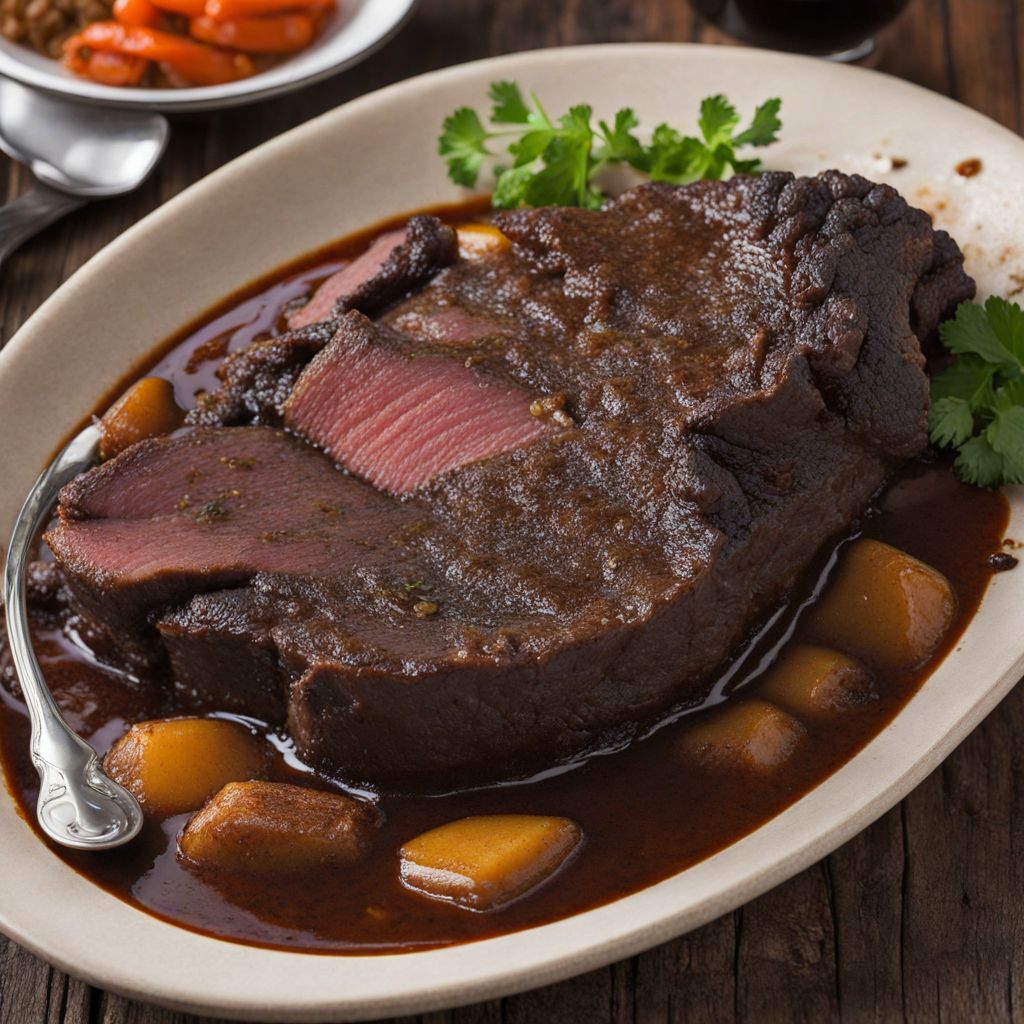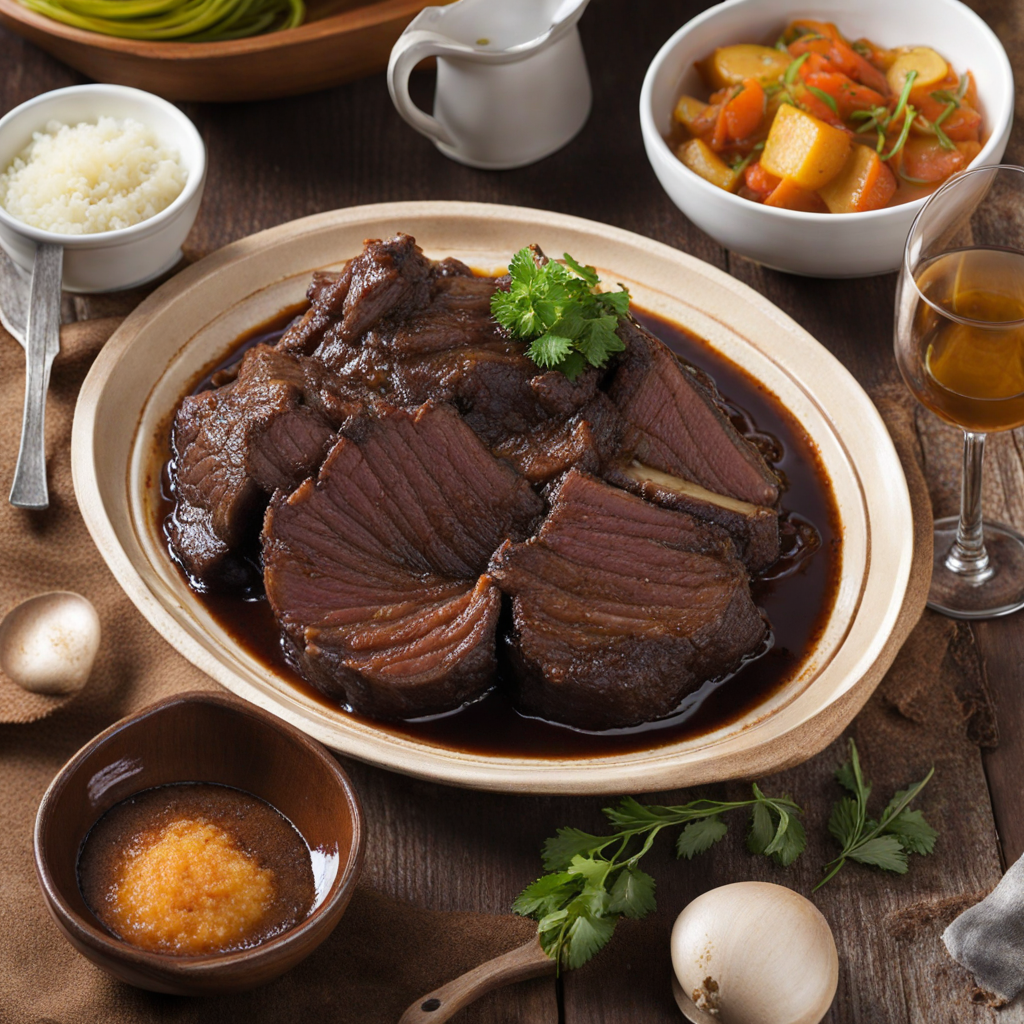Asado Negro
Asado Negro is a traditional Venezuelan dish that showcases a delightful balance of flavors and textures, making it a true culinary gem. This dish features beef, typically a cut like eye of round or brisket, which is slow-cooked to tender perfection. The meat is marinated in a mixture of spices, including garlic, cumin, and black pepper, before being seared to develop a rich, caramelized crust. The star of the show, however, is the sauce—made from a blend of dark brown sugar, soy sauce, and red wine, which transforms into a luscious, glossy glaze as it cooks down with the meat. This unique combination creates a sweet and savory profile that is both comforting and complex. The cooking process of Asado Negro is a labor of love, often taking several hours to ensure the flavors meld beautifully. The dish is typically served with rice, which acts as the perfect canvas to soak up the sumptuous sauce. Accompanying the beef are often black beans or fried plantains, adding further depth and richness to the meal. Each bite offers an experience of tender meat infused with the sweet notes of the glaze, balanced by the savory undertones of the spices—it's a harmony of taste that beautifully represents Venezuelan cuisine. Asado Negro is more than just a main course; it embodies the warmth and hospitality of Venezuelan culture. Often prepared for special occasions or family gatherings, this dish invites sharing and celebration. The vibrant flavors and inviting aroma make it a feast for the senses, encouraging diners to indulge in the rich culinary heritage of Venezuela. With its unique taste profile and heartwarming presentation, Asado Negro is a must-try for anyone looking to explore new and exciting flavors.
How It Became This Dish
Asado Negro: A Culinary Journey Through Venezuela’s Rich Heritage Asado Negro, a sumptuous dish native to Venezuela, is more than just a delicious meal; it is a culinary emblem that reflects the country’s history, culture, and traditions. This slow-cooked beef dish, known for its distinctive dark color and rich flavor, has a story that weaves together indigenous practices, colonial influences, and contemporary Venezuelan identity. #### Origins and Roots The roots of Asado Negro can be traced back to the Spanish colonization of Venezuela in the 16th century. The Spanish brought with them various culinary techniques and ingredients, many of which would merge with local indigenous customs to create a new, vibrant food culture. The use of beef in Venezuelan cooking, particularly in Asado Negro, can be attributed to the Spanish introduction of cattle to the region. The dish itself centers around a cut of beef, typically a roast, which is seasoned and seared before being slow-cooked. The key to its signature flavor lies in the dark sauce that develops during cooking, often made from a combination of sugar, garlic, onions, and spices. The caramelization of the sugar is crucial; it not only enhances the flavor but also gives the dish its characteristic dark hue. #### Cultural Significance Asado Negro holds a special place in Venezuelan culture, often being reserved for significant celebrations and family gatherings. It is more than just a dish; it embodies the spirit of togetherness and festivity. Whether during Christmas, weddings, or birthdays, Asado Negro graces the tables of many Venezuelan households, bringing families together in a shared experience of flavor and tradition. The dish resonates with the concept of “comida de la abuela” or "grandmother's food," a term that evokes nostalgia and warmth. Just like many traditional recipes, Asado Negro is often passed down through generations, with each family adding its own unique twist to the preparation. This personal touch not only preserves family history but also fosters a sense of belonging and identity that is deeply rooted in Venezuelan culture. #### The Evolution of Asado Negro While Asado Negro has maintained its core attributes over the years, its preparation and presentation have evolved, influenced by both regional variations and modern culinary trends. Traditionally, the dish was cooked in a clay pot over an open fire, a method that imbued the meat with a smoky flavor and allowed for slow, even cooking. Today, many Venezuelans opt for contemporary cooking methods, such as pressure cookers or slow cookers, which reduce cooking time while still yielding a tender and flavorful result. Regional differences also play a role in the dish’s preparation. In some areas, the recipe may incorporate local ingredients, such as specific types of peppers or herbs that are abundant in that region. This adaptability showcases the versatility of Asado Negro, allowing it to flourish in various Venezuelan contexts while retaining its identity. #### The Ingredients: A Symphony of Flavors At its core, Asado Negro is about balance and harmony among its ingredients. The base of the dish typically includes a cut of beef, often a chuck roast or brisket, which is prized for its ability to become tender during long cooking times. The sauce is where the magic happens: sugar is caramelized to create a deep, rich flavor, while a blend of garlic, onions, and spices adds complexity. Venezuelan cooks may also choose to add ingredients like bell peppers, wine, or even chocolate to their Asado Negro, reflecting the influence of both indigenous and Spanish culinary traditions. The dish is often served with sides that complement its rich flavor, such as rice, black beans, or fried plantains, creating a well-rounded and satisfying meal. #### Asado Negro in Contemporary Venezuela In recent years, Asado Negro has gained recognition beyond its traditional roots, being featured in Venezuelan restaurants both locally and abroad. Chefs are reinterpreting the dish, infusing it with modern techniques while honoring its traditional essence. This evolution has helped raise awareness of Venezuelan cuisine on a global scale, showcasing the richness of its culinary heritage. Moreover, the dish has become a symbol of resilience for the Venezuelan people, particularly in the face of economic challenges. Many families have adapted the recipe to utilize more affordable cuts of meat or alternative ingredients, demonstrating creativity and resourcefulness. Asado Negro, in this sense, transcends mere sustenance; it becomes a testament to the enduring spirit of Venezuelans who cherish their culinary traditions, even in difficult times. #### Conclusion Asado Negro is a dish that embodies the heart and soul of Venezuelan cuisine. Its rich history, rooted in indigenous and colonial influences, speaks to a broader narrative of cultural blending and adaptation. The dish's cultural significance as a centerpiece for family gatherings highlights the importance of food in fostering community and connection. As Asado Negro continues to evolve, it remains a cherished element of Venezuelan identity, bridging the past and present. Whether enjoyed at a festive gathering or prepared in a home kitchen, Asado Negro serves as a reminder of the power of food to tell stories, evoke memories, and create bonds among people. In every bite, one can taste the history, heritage, and heart of Venezuela, making Asado Negro not just a meal, but a celebration of life.
You may like
Discover local flavors from Venezuela







